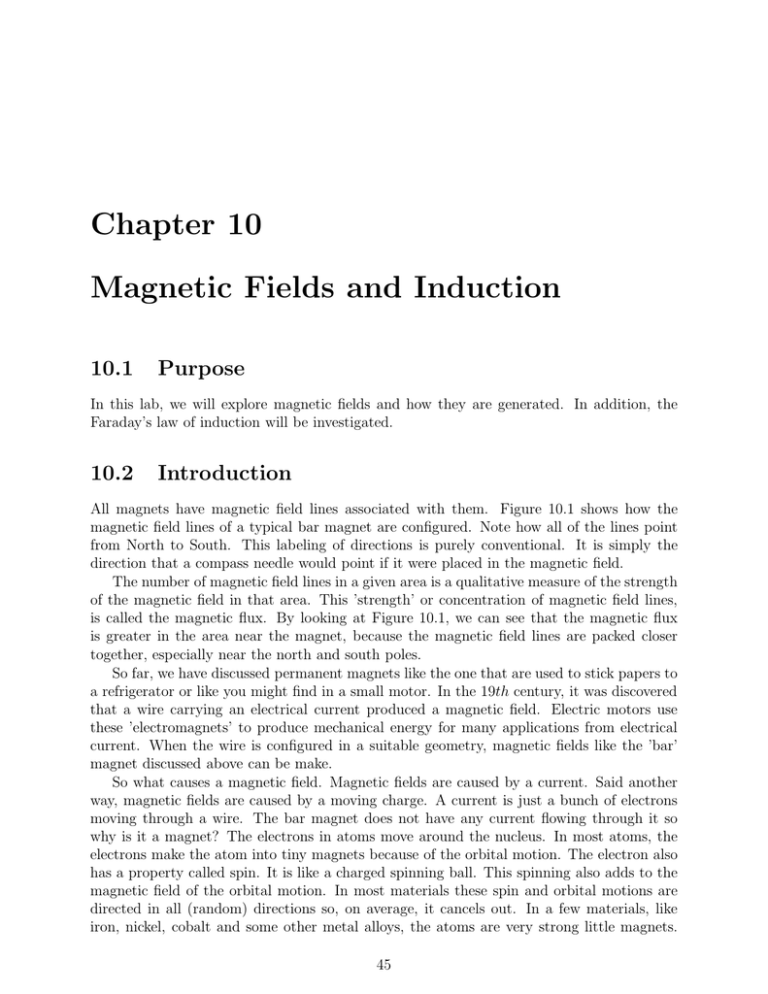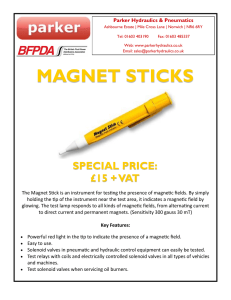Chapter 10 Magnetic Fields and Induction
advertisement

Chapter 10 Magnetic Fields and Induction 10.1 Purpose In this lab, we will explore magnetic fields and how they are generated. In addition, the Faraday’s law of induction will be investigated. 10.2 Introduction All magnets have magnetic field lines associated with them. Figure 10.1 shows how the magnetic field lines of a typical bar magnet are configured. Note how all of the lines point from North to South. This labeling of directions is purely conventional. It is simply the direction that a compass needle would point if it were placed in the magnetic field. The number of magnetic field lines in a given area is a qualitative measure of the strength of the magnetic field in that area. This ’strength’ or concentration of magnetic field lines, is called the magnetic flux. By looking at Figure 10.1, we can see that the magnetic flux is greater in the area near the magnet, because the magnetic field lines are packed closer together, especially near the north and south poles. So far, we have discussed permanent magnets like the one that are used to stick papers to a refrigerator or like you might find in a small motor. In the 19th century, it was discovered that a wire carrying an electrical current produced a magnetic field. Electric motors use these ’electromagnets’ to produce mechanical energy for many applications from electrical current. When the wire is configured in a suitable geometry, magnetic fields like the ’bar’ magnet discussed above can be make. So what causes a magnetic field. Magnetic fields are caused by a current. Said another way, magnetic fields are caused by a moving charge. A current is just a bunch of electrons moving through a wire. The bar magnet does not have any current flowing through it so why is it a magnet? The electrons in atoms move around the nucleus. In most atoms, the electrons make the atom into tiny magnets because of the orbital motion. The electron also has a property called spin. It is like a charged spinning ball. This spinning also adds to the magnetic field of the orbital motion. In most materials these spin and orbital motions are directed in all (random) directions so, on average, it cancels out. In a few materials, like iron, nickel, cobalt and some other metal alloys, the atoms are very strong little magnets. 45 Figure 10.1: Magnetic field lines point from one end of the bar magnet to the other end of the magnet. The direction is the direction that a compass will point at a particular position near the magnet. They have enough magnetic strength to line up in the same direction. Inside of the iron, there are small regions, called magnetic domains where the atom’s magnetic fields are all aligned. When we impose an external magnetic field these magnetic domains all point along the magnetic field lines. In a strong field, the iron will become permanently magnetized. A closely related effect is induction. A changing magnetic field in a loop of wire produces a voltage, technically called an electromotive force (EMF), that causes a current to flow around the loop. The current produced in a loop of wire in this manner is proportional to the change in the magnetic flux that goes through the loop. This effect is named after the 19th century English scientist Michael Faraday. Faraday’s law can be stated as: • The induced voltage in a loop is proportional to the rate at which the magnetic field changes in those loops In a power station, a turbine is turned by high pressure steam. The steam can come from burning coal, natural gas, oil or nuclear fission. There are thermal solar energy plants which use sunlight to generate the steam. The turbine turns a coil in a magnetic field. The induced voltage in the coil is sent out over power lines to power home, offices etc. The rotation of the coil in the magnetic field produces the AC currents we all use in our daily lives. 10.3 Equipment: Galvanometer, wires, bar magnet, solenoid coil, nail, compass and battery. 10.4 Procedure The coil and galvanometer, bar magnet, compass and solenoid coil are shown in figure 10.2 46 Figure 10.2: The galvanometer with the solenoid coil, magnet and compass • Mapping a Magnetic field: Put the bar magnet on a piece of paper and trace it with a pencil. Place the compass on the paper near the magnet and draw an arrow that points in the same direction as the compass needle points at that position. Do this at many different points around the bar magnet until you are able to draw the magnetic field lines around the magnet. Be sure to label the north and south poles of the magnet on your picture, and include this picture in your write-up. • Electromagnets: Using a long straight section of wire, connect each end to a battery in a battery holder. Using the compass, determine which direction the magnetic field points at a fixed distance (1-2 cm) from the wire. Include a description of the direction of the magnetic field around the wire in your report. What happens when you reverse the direction of the current flow? • Wrap several (10-15) loops of the long straight wire around the large iron nail. (The iron ’traps’ the magnetic field lines and concentrates them through the nail.) Using the compass, determine the direction of the magnetic field lines around the nail. Is the pattern more like the permanent bar magnet or the long straight wire? • Induction: A galvanometer is a sensitive meter which detects the flow of an electrical current. Connect a wire to each end of the solenoid coil. Connect the two wires to the galvanometer. The circuit should be connect as shown in Figure 10.3 • Quickly push the bar magnet into the solenoid north end first. Once the needle returns to the default (zero) position, quickly pull the magnet back out of the solenoid. Record the direction the needle moved in each instance. • What happens when you insert the south end of the bar magnet into the solenoid. What direction does the galvanometer needle move when the south pole of the bar magnet is removed? • What happens when to the galvanometer needle when the magnet is inserted slowly? Explain this behavior using Faraday’s law. • With the bar magnet stationary, move the solenoid. Is there any difference in the motion of the galvanometer needle if the magnet is moved or the solenoid is moved. 47 Figure 10.3: Circuit connections for the solenoid and galvanometer. 10.5 Questions • Describe how a power plant might generate electrical power from the wind. • In the induction part of the experiment, why is there no current when part of the magnet is inside the solenoid but not moving? • For the induction experiment, a fixed coil of wire (solenoid) was used and the magnet field changed by moving a magnet. Is it possible to induce a current by changing the geometry of a coil in a constant magnetic field? 48

